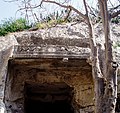Tuvixeddu necropolis
The necropolis of Tuvixeddu (pronounced [tuviˈʒeɖːu]) is a Punic necropolis, the largest in the Mediterranean.[1] It is located in a hill inside the city of Cagliari, Sardinia called Tuvixeddu (meaning "little cavity" in Sardinian).[1]
History
Between the 6th and 3rd centuries BC the Carthaginians chose this hill to bury their dead: these burials were reached through a well dug into the limestone rock (from two to eleven meters deep), a small opening introduced to the burial chamber. The burial chambers were beautifully decorated; there were found amphorae and ampoules for the essences. Of particular interest among the Punic tombs, the "Uraeus Tomb" and the "Fighter Tomb", decorated with paintings of palm trees and masks, still well preserved. Another famous tomb is that "of the Wheel".
On the slopes of the Tuvixeddu hill there is a Roman necropolis, which overlooked the road at the exit of the city. The Roman necropolis consists mainly of arcosolium tombs and columbaria.
The necropolis opened to the public in May 2014, during the XVIII edition of Monumenti Aperti. The archaeological area is large, it originally consisted of an area of about 80 hectares (200 acres).
Paleogenetics
A 2017 Ancient DNA study by Claudia Viganó et al. found that a man buried ~2000 years ago in the necropolis of Tuvixeddu carried the cod39 mutation that cause Beta thalassemia. The paternal and maternal haplogroups of this individual, suggests that he was likely autochthonous of Sardinia.[2]
Gallery
- Aerial view of the site
-
 Reconstruction of a punic tomb of Tuvixeddu
Reconstruction of a punic tomb of Tuvixeddu -

-
 Decoration of the Ureaus tomb
Decoration of the Ureaus tomb -
 Roman tomb
Roman tomb -
 View of the hill of Tuvixeddu (center)
View of the hill of Tuvixeddu (center)
References
- ^ a b "La necropoli punica di Cagliari. Tuvixeddu, un colle e la sua memoria". sardegnadigitallibrary.it (in Italian).
- ^ Viganó, Claudia; Haas, Cordula; Rühli, Frank J.; Bouwman, Abigail (2017). "2,000 Year old β-thalassemia case in Sardinia suggests malaria was endemic by the Roman period". American Journal of Physical Anthropology. 164 (2): 362–370. doi:10.1002/ajpa.23278. PMID 28681914. Retrieved 8 November 2022.
Sources
- Tuvixeddu – Un colle da salvare (in Italian). Cagliari: Legambiente. 1993.
- Marcello Polastri, ed. (2001). Cagliari, la città sotterranea: grotte, cisterne, necropoli e cavità segrete (in Italian). Cagliari: Edizioni Sole.
- Tuvixeddu. La necropoli occidentale di Karales (in Italian). Cagliari: Della Torre. 2000. ISBN 88-7343-323-5.
- Tuvixeddu. Tomba su tomba (in Italian). Cagliari: Archaeological Superintendence of the Provinces of Cagliari and Oristano. 1998.
- Roberto Copparoni; Angelo Pili; Marcello Polastri (2013) [1997]. Tuvixeddu vive (in Italian). Cagliari: Artigianarte. IT\ICCU\CAG\0029495.
- Roberto Copparoni, ed. (June 2014). Carta turistica di Tuvixeddu (in Italian). Translated by Annalisa Pirastu. Associazione di volontariato Amici di Sardegna Cagliari.
External links
- Special about Tuvixeddu on the official website of the Autonomous Region of Sardinia (in Italian).
- The "Grotto of the Viper" (Grotta della Vipera) on SardegnaMappe (in Italian).
- Portal about underground explorations in Tuvixeddu (in Italian).
















